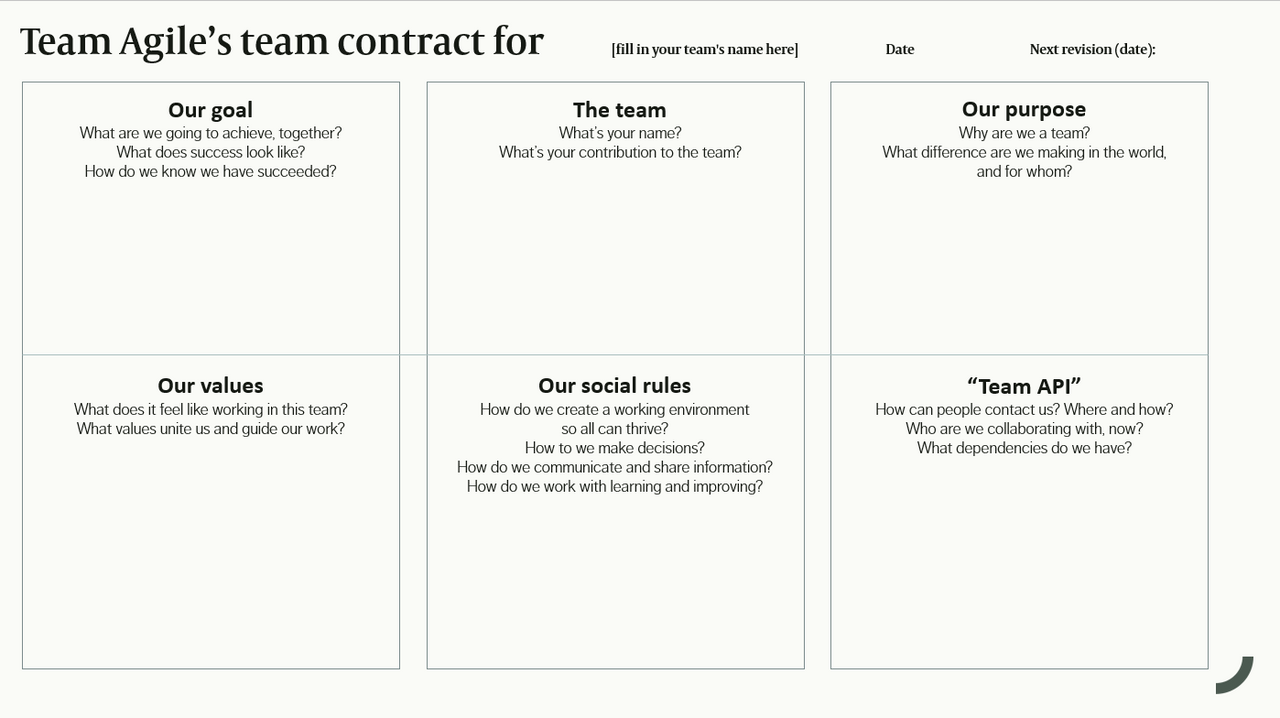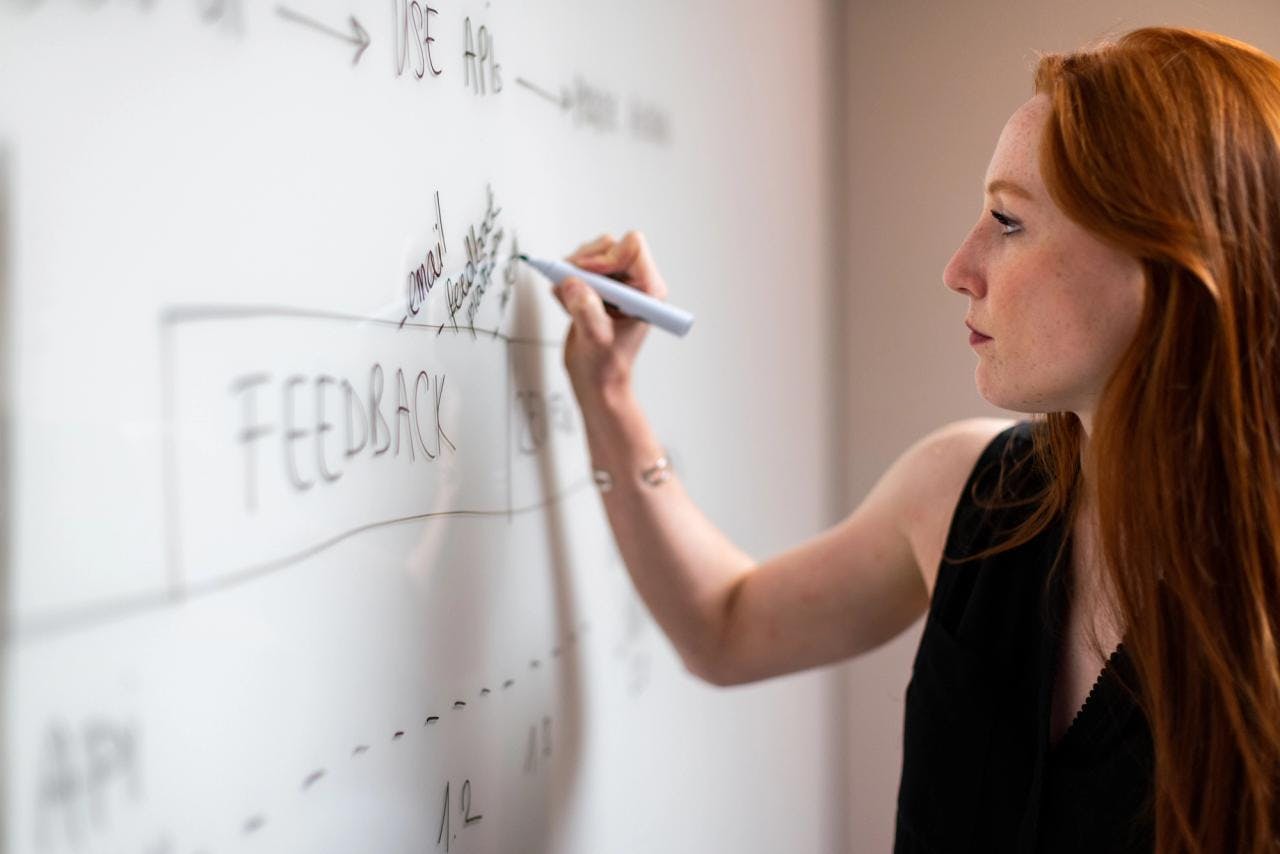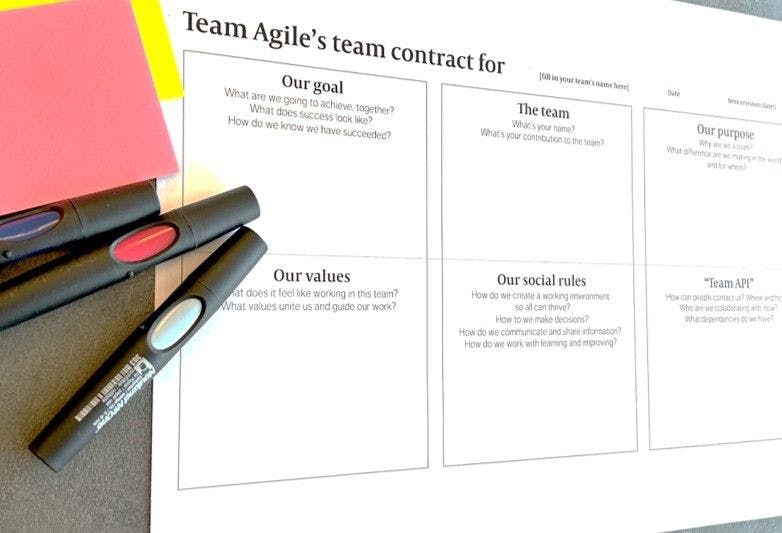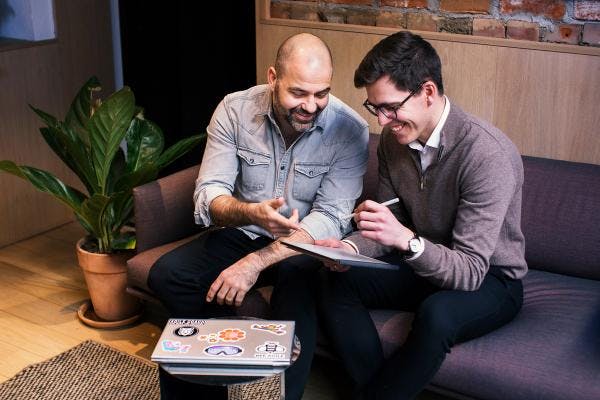High-performing teams have a team contract
Team contracts are vital for making a high performing, cross-functional team. As we strongly believe, such teams are the most effective way to solve complex problems. But good teams don't just happen on their own. According to team literature, up to 70% of every team fail to achieve their goals. To function properly, teams need to be regularly maintained. A team contract helps with this. Read more to learn more and make a team contract.
High-performing teams have a team contract
A team contract is a simple tool that you can use to make your team's norms and expectations explicit. It is a written agreement between team members that outlines expectations, goals, roles, and responsibilities for each team member. It helps you address questions that have proven to be important in building good teams. These are crucial for any team and especially for hybrid teams. Hybrid teams have to focus on more explicit communication to make them work, and the team contract helps on just that. Team Agile’s team cntract has six questions that all teams can benefit from discussing together.
There is no exaggeration in saying that Team Agile is passionate about teams. We have previously written about team contracts, Team Canvas, Team Canvas Basic, reasons why teams do not work. A lot has been written about psychological safety and health checks for teams. There is also no shortage of team contracts: Team Canvas, Scrum Team Charter, Start Smart, and Team API, to name a few.
Team dynamics matter more than who's on the team
In recent years, there have been several studies on what characterizes high-performing teams. The Aristotle study from 2018 summarized Google's search for the perfect team. After studying 180 teams, they concluded that what team members do is far more important than who is on the team. The solution to building effective teams lies in the group's norms, and how participants interact with each other. This collaborative climate has been named high psychological safety by, among others, Amy Edmondson, and studies have shown that creating a team contract has a positive effect on psychological safety in the team because it’s promoting knowledge sharing, and a learning mindset in the team.
Team norms significantly affect the team's performance
European researchers have come to the same conclusion in a 2020-study, saying that the team's norms significantly affect team effectiveness. The way teams approach learning, and development is therefore crucial to understanding why some teams are far more effective in creating value than others. In other words, the best teams are not only in agreement about the goal they are working towards. They agree on rules of engagement, norms, and expectations that participants have of each other. And through this, they can create a healthy and efficient climate for communication and collaboration in the team. In our experience from working with more than 70 teams, as well as documented in meta-studies, the best teams have a team contract.
A type of psychological contract
The team contract is not like a signed contract where violations are punished. It sets the expectations for each other to be able to hold the team accountable for its work. The team contract is a physical or digital "poster" where participants' expectations and social rules of engagement are listed. A visible team contract guides the behavior in the team. It has similarities with what research calls a "psychological contract." A psychological contract regulates perceived but unspoken obligations towards each other, which participants nevertheless experience and implicitly adhere to. It is about mutual expectations of each other. It is an invisible, unwritten agreement that is about the exchange relationship and mutual expectations in a collaboration.

A study examined how breaches of psychological contracts were experienced by employees. The study found that employees became less engaged, had lower job satisfaction, and performed worse when there were breaches. The point is not to punish negative behavior, but to hold people accountable to each other and to the team's goals/task. In our opinion, a team contract is about team accountability, mutual responsibility to do one's best and to take the team and collaboration seriously.
A tool for clear and mutually agreed collaboration
Psychological contracts are the unspoken expectations and obligations between employees and their employers or colleagues. When these expectations are not met, employees can experience a sense of betrayal, which can lead to a decrease in motivation and job satisfaction. This is why it is important for teams to have a clear and mutually agreed-upon team contract.
The purpose of a team contract is not to micromanage or to create a rigid set of rules. It is rather to set up a framework for how the team will work together, what their goals are, and what each member's responsibilities and expectations are. This can help to create a sense of accountability and ownership within the team.
Team Agile’s team contract
As the saying goes, self-made is well-made, and that also applies to team contracts. We have created our own based on having used and helped make team contracts for over 70 teams. The team contract is inspired by several of the above mentioned team contracts, and is fit to purpose based on Team Agile’s experience is most important in creating good and effective collaboration.

It is also adapted to our work with cross-functional teams responsible for creating digital products that are loved by the customers and also provides value to the business. Based on our experience, teams that explicitly regulate their inner team relationship and collaboration, tend to succeed better than teams that don’t. This is where the team contract comes in.
When creating a team contract, it is important to involve all team members in the process. This can help to ensure that everyone's expectations and concerns are heard and addressed. The team contract should be reviewed regularly and updated as necessary to reflect any changes in the team's goals or dynamics.
Overall, a team contract can help to create a culture of responsibility and collaboration within a team. By clearly defining expectations and responsibilities, team members can feel more engaged and motivated, and can work together more effectively to achieve their goals.
How to make it
In simple terms, creating a team contract is much about making the work as easy as possible. It is about establishing a framework for what good team dynamics and collaboration look like for you. A draft on how to build the team you need to succeed. A team contract helps you with this. The contract itself consists of six themes that serves as starting points for team discussion. These themes are the basis for team members to express and come to a mutual understanding of the team's goals, roles, and values.
Covering three crucial aspects of teamwork
Broadly speaking, the team contract consists of three "areas":
- Goals and purpose: what are we trying to achieve and why are we doing it.
- People, roles, and responsibilities: who are we and how we contribute.
- Shared norms, social rules, and communication – how we’re going to collaborate to reach our goals.
A team contract helps the team reflect on and discuss the shared goals and purpose of the team, as well as the "soft" values of interpersonal collaboration that are often not talked about. The contract helps create openness, social safety, and good guidelines for how the team can function and work together in the best way. This applies to both new and existing teams that have worked together for some time.
What to keep in mind when creating a team contract
The team contract structures discussions about the team's goals, roles, norms, and social rules. Each team participant’s response reflects their needs or viewpoint; there is no right or wrong answer. Participants can challenge each other by asking open-ended questions and thinking through their own positions, but the team owns the content. What the team and participants believe is right is what counts.
The team contract does not have to be followed like a recipe, step by step. Implementation, sequence, and questions can be adapted if the team wishes, or the situation requires it. Try Team Agile's recipe the first time you do the exercise. And feel free to adapt it to your team’s needs next time. A team contract requires the team to agree and find "common ground" in all six areas.
The facilitator's role
Filling out a team contract takes place in a workshop where there is time for both individual thinking and group discussion. Find a facilitator who creates good frameworks and ensures progress in the session. Often, this is the team leader, Scrum Master, or agile coach, but it can really be anyone, even someone outside the team. The role is to facilitate the work session for the team. This guide provides help on the facilitation.

How to facilitate the team contract workshop
A team contract workshop takes time the first time you do it with your team. It depends on how good the team members know each other, how long they have worked in the company and how much team development the team is familiar with. For the first time, we recommend booking a 2–3-hour workshop and seeing how far it gets you. Sometimes it’s difficult to agree on a common goal from the beginning, which means that calibrating everyone’s viewpoints takes time.
It's about having good enough discussions to agree and find common ground. Sometimes the facilitator must cut discussions to make sure progress is made in the workshop. So make sure to keep track of time in the discussions. A technique we use is to timebox discussions, in combination with roman voting. It is a technique that gives the team the power to decide whether a discussion about a topic is to be continued or stopped after a set amount of time and is ready to move on.
Principles for facilitating the workshop
The session begins with the facilitator briefly explaining the purpose. Then, the questions on the canvas are read aloud. Each participant writes down their thoughts and proposals on stickies. When all participants are finished writing, the participants present their notes to each other. Finally, the team discusses all the proposals, agrees if necessary, and moves on to the next field.

The facilitator times the session and ensures that the participants are focused and contribute to the exercises. If any discussions drag on or the team does not find common ground, the discussion can be set aside until the rest of the exercise is complete. Plan a separate meeting to follow up on the unresolved discussion as soon as possible.
Give people time to think for themselves
Each session begins with the facilitator asking questions to the group. Participants have a set number of minutes to write down their thoughts and proposals on post-its, one point per note. When the time is up, participants present their notes while they are hung up on the board. Participants take turns presenting their notes for each session.
As participants present their notes, there are often duplicate or overlapping notes. These can be grouped. Then the team votes for the notes and agrees on what should be included in the team contract. It should not be more than approx. 3-5 topics in each field of the team contract, to make it easy to remember and follow.
The order of the team contract discussions
This is how we normally structure the discussions in the team contract:
- The team starts with finding a (memorable) team name. It creates team spirit and makes it easy for others to contact the team.
- The team members: What’s your name and what is your role and contribution to the team.
- Goals: To be a team, you need a common goal. Discuss what the team is to achieve together, what success looks like and how you know when you have succeeded.
- Purpose: Why are we here? What’s our joint purpose? Agreeing on the why is about seeing the team’s goal in a bigger context.
- Team values and “feel”: Agreeing on common values is important to understand what it should feel like working in the team.
- Social rules: The social rules should reflect the earlier discussions. The idea is to agree on 3-5 rules that guide the team’s work. It’s about figuring out how to make decisions, how to communicate, share information and work with structured learning and improvement. The rules must be easy to follow and easily formulated
- “Team API”: Lastly, the team finds some principles on how other people and teams can get in contact with the team. The Team API should also tell who the team collaborates with, potential dependencies to others and where information is shared. This is crucial for effective communication and keeping the cognitive load low.

To sum up and complete the first edition of the team contract, the facilitator goes quickly through the team contract and reiterates all the agreed-upon points after the various exercises. Decide when a revision of the team contract will take place. Ensure that the team contract is displayed or linked in a way that is visible to the team and those around the team in their everyday work.
Repetition and renewal of the team contract are success factors.
A team contract should be updated or renewed periodically to ensure it is still alive and relevant, perhaps a couple of times a year or when new members join (or leave) the team. The team contract is a fantastic way to introduce new team members to the team quickly. The purpose is not the document itself, but to ensure continuous agreement on the team's shared rules and norms. By experiencing mutual interdependence and trust in each other, the team will become a good working environment for the participants while effectively collaborating towards their common goal.
Hence, repetition and renewal of the team contract are success factors for making it work. Put the team contract on the agenda in the next team meeting after it has been made. The purpose is to ensure that everyone on the team is still in agreement or if there is a need for changes. The team contract serves as the team's common guidelines and a living document owned and adhered to by all team participants. Everyone on the team must uphold the values and guidelines they helped create for the team.

Do you need help or have questions?
If you need help or have questions about the team contract, Team Agile is dedicated to accelerating value creation through awesome teams. We have created team contracts with more than 70 teams and have years of experience that we are happy to share with you. If you want to learn more about teams, team dynamics, and collaboration, please feel free to reach out☕
FAQs
How do team contracts specifically address and resolve conflicts within teams?
Team contracts often include conflict resolution protocols, providing a pre-agreed method for addressing disagreements. This might involve regular feedback sessions, mediation processes, or escalation paths. These contracts foster an environment where issues can be discussed openly and constructively, minimizing the impact of conflicts on team dynamics.
What are some common challenges teams face when implementing a team contract, and how can these be overcome?
Common challenges include resistance to change, lack of engagement, and misunderstanding of the contract's purpose. Overcoming these obstacles often requires clear communication of benefits, involving the team in the creation process to ensure buy-in, and revisiting the contract regularly to make adjustments as the team evolves.
Can the principles of a team contract be applied to virtual teams, and if so, how?
For virtual teams, team contracts are especially crucial for establishing clear communication norms, availability hours, and digital tool use. The creation process might involve virtual workshops and regular online check-ins to ensure all team members feel connected and aligned with the contract’s terms, helping to bridge the gap caused by physical distance.


